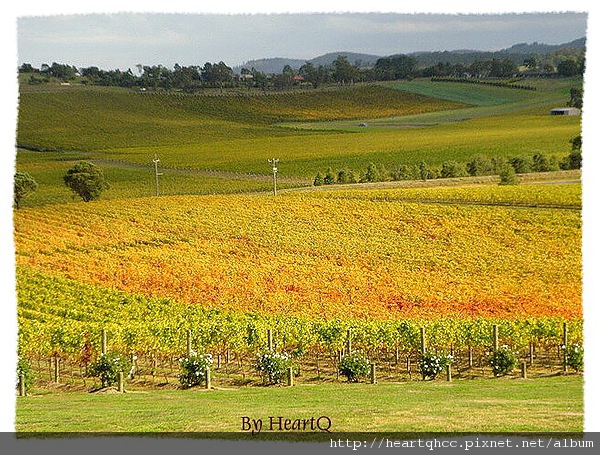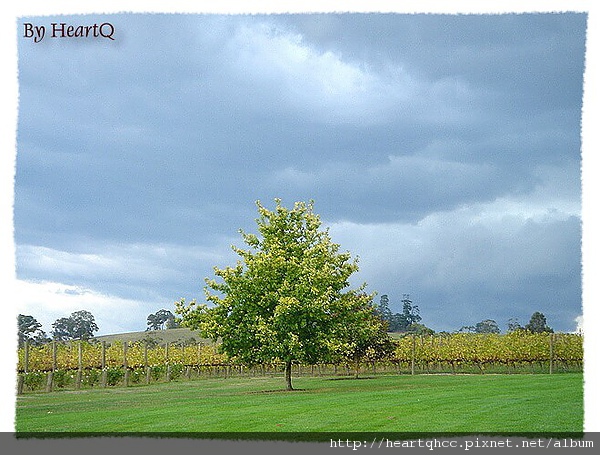
去年大約此時,HeartQ、森太郎和朋友們上美麗丘(Marysville)三天兩夜,到雅拉嶺國家公園(Yarra Range National Park )玩雪去(就是去看褲ㄎㄚ不拉的那次)。我們運氣真的不錯,第二天上滑雪地玩雪橇板和捏雪人時,天氣很好,之後上山攻頂,又見識到台灣和澳洲都難得一見的大雪紛飛。
這裡有兩個玩雪橇板的地點,我們兩個地方都去了。由於剛去時積雪不深,造雪機不停的噴打著雪,即便如此,因為遊客眾多,被踩得硬硬的雪地變得滑得很。拿著雪橇板走路得小心翼翼。放下、坐穩,咻~一下,就順著彎彎陡陡的斜坡滑到底。然後拿著雪橇,移動穿著雪衣像熊一樣的身體,再提著厚厚重重穿著雪鞋的腳,一步步慢慢踩雪上坡,找個好位子,再放下、坐穩,咻~,又一次。這個運動連續做個一兩個小時,也是會累哩,周圍溫度很低,可是卻走得滿身汗。下圖中間就是我們玩雪橇板的其中一個地方。那,滑雪呢?HeartQ和森太郎以前雖然嘗試過滑雪課,可是老骨頭加上過敏鼻,流鼻水又摔得爬不起來,實在無法enjoy那種在颼颼冷風中衝刺怕跌倒的「快」感,所以,謝啦!玩雪橇就很刺激了。
玩累了,來捏雪人。雪球,是天上剉下細細的雪花冰揉成的。看起來簡單,不知道是沒有道具還是沒天份,嗯,應該是兩者都有,總之,我們的雪人捏起來,怎麼都沒有在地老澳捏得好看。
收拾完雪橇、滑雪板之後,大家直上山頭,攻頂。頂上的積雪很厚,腳踏下的痕印,深深地陷在雪裡。森太郎躺在雪地上,印了一個「命案現場」的身形,很好玩兒(可惜一片雪白,照片照不清楚,所以沒放上來)。走著走著,就飄起雪片兒來了。到達山頂時,雪大得不得了,大家的身上,臉上白白地覆了一層霜。在這山頂人稀處,還有一個小小雪人兒,正迎著風雪,悄悄長大(見上圖中)。
雪持續地下著,回到停車場時,已是一片白茫茫。積雪大概又厚了好幾吋,改天來玩雪的人,就不再需要造雪機了(下圖)。
第二天沿著溪邊彎彎長長好幾里的步道上山看瀑布,這是HeartQ和森太郎第二次走這個步道。經過第一次膝蓋走到廢掉的教訓,這回特別穿了登山越野鞋來,總算可以輕鬆上下山了。然後,晚上是很豐盛澎湃的火鍋餐(下圖)。
第三天經過雅拉谷,自然又是去品酒。這回,發現和森太郎同年的~葡萄樹,合照一張,來。

 雅拉谷是維多利亞州著名的葡萄酒區,有許多大大小小的葡萄酒園、釀酒廠及餐廳。這次我們去的De Bortoli和沿自法國的「香冬區」(Domaine Chandon)酒莊,對我和森太郎來說都不陌生,來了好幾次了,以前甚至還曾在De Bortoli用餐,及在Domaine Chandon品酒廳品酒和乳酪呢。這兩家大酒莊都有很漂亮又大片的葡萄園,尤其是香冬酒莊,經營的很有規模,也有開放指導員說明的酒廠參觀行程喔(不過這次大家沒能趕上參觀酒廠,因為在「弟伯偷李」酒莊野餐和玩123木頭人玩得高興地過頭,也忘了時間了)。
雅拉谷是維多利亞州著名的葡萄酒區,有許多大大小小的葡萄酒園、釀酒廠及餐廳。這次我們去的De Bortoli和沿自法國的「香冬區」(Domaine Chandon)酒莊,對我和森太郎來說都不陌生,來了好幾次了,以前甚至還曾在De Bortoli用餐,及在Domaine Chandon品酒廳品酒和乳酪呢。這兩家大酒莊都有很漂亮又大片的葡萄園,尤其是香冬酒莊,經營的很有規模,也有開放指導員說明的酒廠參觀行程喔(不過這次大家沒能趕上參觀酒廠,因為在「弟伯偷李」酒莊野餐和玩123木頭人玩得高興地過頭,也忘了時間了)。 

















 (圖一)七月的大清早,嗯,這間我們常來的民宿昨晚好像又住進了一批人,不知道今天早上有沒有什麼好康的可以分一點~。咦,今天好像我最早到,其他幾個龐克,到底還有什麼鳥事還沒處理好嘛?就我一個來,會不好意思ㄋㄟ,先站在角角看看情況好了。
(圖一)七月的大清早,嗯,這間我們常來的民宿昨晚好像又住進了一批人,不知道今天早上有沒有什麼好康的可以分一點~。咦,今天好像我最早到,其他幾個龐克,到底還有什麼鳥事還沒處理好嘛?就我一個來,會不好意思ㄋㄟ,先站在角角看看情況好了。 







 我的部落格蒐藏
我的部落格蒐藏 